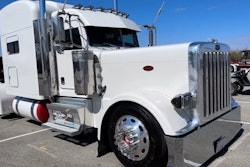The Goodyear Racing transporter leaves the UPS equipment staging area in Laredo, Texas to cross the border for the first-ever NASCAR race held outside the United States.
Mexican Convoy
The NASCAR Busch Series’ visit to Mexico City was historic in that it marked the first NASCAR points race ever held outside the United States, but it also created some new logistical obstacles for the teams. Getting teams to and from Mexico meant special document requirements, advance coordination between U.S. and Mexican officials, and security and staging for expedited border crossings.
UPS was put in charge of logistics support for the 80-lap road race at the Autodromo Hermanos Rodriguez.
UPS manifested and sealed all NASCAR and team equipment, coordinated international logistics and synchronized more than 80 team haulers, official trailers of technical scoring and template equipment, tires, emergency and safety vehicles and media trucks across the border in multiple convoys.
Equipment arrived at the UPS Logistics Center in Laredo, Texas, from all across the country, according to Tom Page, director of solutions and marketing for Latin America, UPS Supply Chain Solutions.
“Most of the Busch series teams will compete the weeks before and after the Mexico race, and NASCAR needs comprehensive knowledge of every detail on each of the shipments from coast to coast, as well as plans for exchanges of equipment in staging,” he says.

Following the rapid clearance, convoy groups crossed the World Trade Bridge to begin the approximate 20-hour nonstop trip to Mexico City. Each convoy had federal and private security escorts, as well as coordinated communications en route. UPS completed all procedures in reverse after the checkered flag at the Sunday race for reentry into the United States for the race the following weekend.
Normally, NASCAR teams – especially their transport drivers – don’t have to worry about dealing with the laws and logistics of a foreign government, but the Mexico 200 meant doing just that – and was yet another step forward in the globalization of the stock car sanctioning body.
Motorsports Greats Cited
Twelve legends of U.S. motorsports have been nominated for the American Auto Racing Writers and Broadcasters Association’s Newsmaker of the Half-Century Award, the most important event of AARWBA’s 50th Anniversary Celebration.
The full AARWBA membership will now vote for one of the 12 as Newsmaker of the Half-Century, and their choice will be revealed at a public ceremony prior to the 89th running of the Indy 500 this month. Here’s a quick look at the nominees and their accomplishments:
Mario Andretti is regarded by many as one of the country’s most versatile drivers ever, with victories in the Indy 500, NASCAR’s Daytona 500 and Sebring 12 hours. He was the 1978 world Formula One champion. He retired in 1994 with four Indy Car championships and 52 race wins, earned over a record four decades, the last at a record 53-plus years old. He finished with Champ Car records for starts, poles and laps led, and he was voted Driver of the Quarter-Century in 1992.
Kenny Bernstein captured six NHRA drag racing titles, four in the Funny Car class and two in Top Fuel, but perhaps he is best known as “The King of Speed” after becoming the first driver to make a 300 mph quarter-mile pass in 1992. He retired after the 2002 season but returned in ’03 to sub for injured son Brandon, and won four times to bring his career total to 69 victories. He earned a reputation as a pioneer in the business of motorsports with 26 consecutive years of Budweiser sponsorship and other ventures. His teams also won the Indy 500 pole and NASCAR Cup and CART races.
Dale Earnhardt was a seven-time NASCAR Cup champion, tying Richard Petty’s record, and achieved legendary status as “The Intimidator.” He won 76 Cup races, including the Daytona 500 and Brickyard 400, and earned more than $41 million in Cup prize money alone. The team he founded, DEI, has fielded winning cars for several drivers, including son Dale Earnhardt Jr. His death on the last lap of the 2001 Daytona 500 was headline news around the world.
John Force won his 13th NHRA Funny Car championship in 2004, a total which includes a streak of 10 consecutive titles from 1993-2002. Five victories in ’04 brought his career total to a record 114 wins in 180 final-round appearances. He’s a four-time winner of the U.S. Nationals, the series’ biggest event. He is recognized by media as one of the most colorful interview subjects in any sport.
A.J. Foyt was viewed as an American racing icon for his exploits on dirt and paved tracks, even before he became the first four-time Indianapolis 500 winner in 1977. He earned a record seven Indy Car championships and won a record 67 Indy-type races before his retirement in 1993. He also has five titles in other series, plus victories in the 1967 24 Hours of Le Mans and 1972 Daytona 500. Foyt made a fifth trip to victory lane at the Indy 500 as a car owner in 1999 and fielded the IRL championship team in 1996 and 1998.
The France family has led NASCAR to a position as the No. 2 sport in America, behind only the NFL. William H.G. (“Big Bill”) France promoted the famous beach/road races in Daytona Beach and founded the stock car organization in 1947. He built Daytona International Speedway and Talladega Superspeedway. He died in 1992. William C. (“Bill”) France succeeded his father as NASCAR president in 1972 while another son, Jim, became president of the family-founded International Speedway Corp. Bill steadily grew NASCAR into a true nationwide series that even came to the Indianapolis Motor Speedway starting in 1994. National TV exposure and prize money greatly increased. Bill’s son, Brian, succeeded his father as NASCAR chairman in October 2003 and quickly revolutionized the series by instituting the “Chase for the Championship” format in 2004. Bill’s daughter, Lesa Kennedy, is a member of the NASCAR Board and president of ISC, which has built and acquired several major tracks in recent years. Jim now serves as vice chairman of both NASCAR and ISC, and his son J.C. is a winning driver in the Rolex Sports Car Series.
Jeff Gordon raced his way from short tracks as USAC midget and Silver Crown champion to the top of NASCAR’s Cup series in the 1990s and was hailed as “NASCAR’s Tiger Woods” as he helped elevate the sport to a higher level of popularity and interest in the mainstream media by hosting shows such as Saturday Night Live and Live with Regis and Kelly. He won the historic inaugural Brickyard 400 at Indianapolis in 1994 and has gone on to claim that event a record four times, including 2004. He is a four-time NASCAR Cup titlist and has won the Daytona 500 three times in his total of 70 Cup victories.
Dan Gurney is considered by many to have been America’s greatest international road racer. He competed in the world Formula One championship for many years and scored a satisfying victory in the 1967 Belgian Grand Prix in an All-American Racers Eagle of his own design and construction. He also teamed with Foyt to win Le Mans that year.
Gurney won important NASCAR, sports car and Indy-type races before his retirement after the 1970 season. He forever influenced Indy racing by helping to convince Lotus Formula One team owner Colin Chapman to build a lightweight, Ford-powered rear-engine car for the Indy 500 in 1963. He owned the 1975 Indy winning car, driven by Bobby Unser, and successful CART and IMSA teams.
The Hulman-George family is responsible for making the Indianapolis 500 “The Greatest Spectacle in Racing” and the world’s largest single-day sporting event. Anton (“Tony”) Hulman purchased the Indianapolis Motor Speedway in 1945 and quickly began to upgrade the facility, which was in disrepair after World War II. In the following three decades he continued an aggressive program of track improvements and worked to build-up the now-traditional month of May activities surrounding the race. Hulman also was involved in the founding of the U.S. Auto Club. He died in 1977, and wife Mary Fendrich Hulman assumed the title as chairman. She died in 1998. Their daughter, Mari Hulman George, was named chairman in 1988. The winner’s purse exceeded $1 million for the first time in 1989. Anton (“Tony”) H. George, Tony Hulman’s grandson, became Speedway president in 1990. He continued the on-going track improvement effort leading up to his historic decision to bring NASCAR to the Speedway for the inaugural Brickyard 400 in 1994. In 1996, George launched the Indy Racing League, then constructed an infield road course to stage the Speedway’s first U.S. Grand Prix Formula One race in 2000. IMS helped develop the groundbreaking SAFER barrier system and was the first to install it in 2002. George’s stepson, Ed Carpenter, is an IRL driver.
Wally Parks was the driving force behind the creation of the National Hot Rod Association in 1951 and built the drag racing sanctioning organization into a successful governing body with Top Fuel, Funny Car, Pro Stock and Pro Stock Motorcycle professional classes. He started in the late 1930s with the Southern California Timing Association, which focused on conducting land speed record events, and in the late 1940s became the first editor of Hot Rod magazine. He later was editorial director for all the Petersen auto magazines. He stepped down as NHRA president in 1984 but remained chairman. Now in his 90s, Parks is still on the NHRA Board and is chairman of the Wally Parks NHRA Motorsports Museum in Pomona, Calif.
Roger Penske is the winningest car owner in Indianapolis 500 history, with 13 victories, and his team has been the most successful ever in U.S. open-wheel competition with 11 championships and more than 120 wins. He was one of America’s top young road racers before retiring in 1965 to concentrate on business. Since 1966, Penske’s team has won in every type of racing it entered, including NASCAR, Formula One and various sports car series for an additional seven titles. He has employed some of history’s greatest drivers, including Mark Donohue, Rick Mears, Mario Andretti, Bobby Unser, Al Unser, Al Unser Jr., Emerson Fittipaldi, Danny Sullivan, Bobby Allison and Rusty Wallace. Penske Cars has designed and built numerous championship machines. Penske is widely regarded as racing’s foremost entrepreneur; he owned or built tracks such as Michigan Speedway and California Speedway, and was a co-founder of CART.
Richard Petty set the standard for success in NASCAR with a record 200 Cup victories and seven championships before his retirement after the 1992 season. His historic 200th win came at Daytona in the July 1984 Firecracker 400 and was witnessed by President Ronald Reagan. He also holds the record for Cup starts, poles and wins in a season, 27, in 1967. His fan- and media-friendly personality helped earn him the title “The King,” and he made the No. 43 NASCAR’s most famous car. He won the Daytona 500 a record seven times. He remains active in NASCAR as owner of the Petty Enterprises car.








